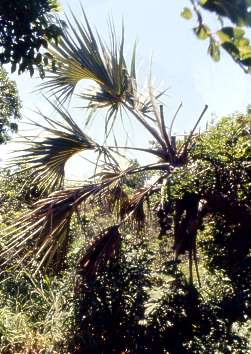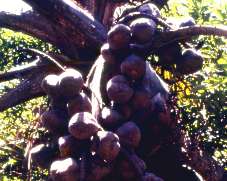Hyphaene coriacea
Hyphaene coriacea Gaertn.
Family: Arecaceae
Common names: lala palm, ilala palm, gingerbread tree, fan palm (Eng.); lalapalm, palmboom, waaierpalm (Afr.); Lala-Palme (German); Lilala (Swati); Nnala (Tsonga); Mulala (Venda); iLala (Zulu)
SA Tree No: 23
Introduction
Could large scale exploitation of lala palms make a significant contribution to the economy of northern Zululand? Almost all parts of this very common palm are used for something, and feasability studies have been done on the economics of some aspects of this palm. plant.

Description
Description
Ascending to prostrate palm up to 5 m tall. Trunks many, straight,with prominent, discontinuous, large leaf scars; unarmed. Leaves spirally arranged, costa-palmate (fan-like, with a midrib), blue-grey. Petiole margin with teeth ± 10 mm apart, 10 mm long, forward pointing. Leaflets 2-ranked, erect, evenly spaced, with the central fold down (induplicate), with one fold each, linear. Lamina up to 400 x 35 mm. Tips simple, acute, smooth, straight. Leaf bases persistent, scale-like, split, without an inner auricle, woody.

Inflorescenc ebetween the leaves, branched, pendulous, 0.4-1.0 m long. Plants are dioecious (separate male and female trees). Male inflorescence slenderer and more branched than female. Male flowers in threes,in pits; sepals joined, stamens free, 6. Female flowers solitary, perianth like males; carpels united, styles free, stigmas almost sessile. Ovary and fruit smooth. Fruit brown, stepped, fibrous, 30-60 x 15-40 mm.
Conservation Status
Status
This common and widespread palm neither needs nor receives protection. Moll (1972) estimated the population in Kwazulu-Natal (KZN) alone at over 10 000 000 individuals.
Distribution and habitat
Distribution description
This palm is often seen growing near but not on the banks of rivers in knobthorn-marula savanna on basalt. In the Kruger Park both southern African species of Hyphaene may be found quite close to each other. It is also common in coastal sand from Somalia to South Africa,and in Madagascar; rarer inland.
Derivation of name and historical aspects
History
The generic name is derived from the Greek hifinein, to weave,and refers to the net-like, fibrous mesocarp (middle layer) of the fruit. The specific epithet coriaceus means thick and leathery; this could apply to most parts of this palm, but particularly the leaves. The synonym natalensis by which it was known until relatively recently signifies a resident of Kwazulu-Natal province,South Africa. But does anyone know why it is called a lala palm? None of theNone of the references mention the derivation of this common name.
It is quite difficult to distinguish the two species of Hyphaene in southern Africa where their geographic ranges overlap, as in the lowveld of Mpumalanga and the Northern Province. Indeed the only reliable character that can be seen at a distance is the shape of the fruit: in H. coriacea the fruits are distinctly indented to pear-shaped, but those of H. petersiana (northern lala palm) are not indented and so elliptical to ovoid. Keen dendrologists visiting the Kruger National Park may spend many happy hours disentangling almost indistinguishable palms (and amazing other tourists!).
It seems that the name H. crinita auct. non Gaertn. has on occasion been used for H. coriacea in southern Africa. Dransfield (1986) indicates that it has also been misapplied to an East African species, H. compressa H.Wendl. Information given by southern African authors for H. crinita has been reported under this species, with no great assurance that it belongs here.
There are about 10 or 12 species with 41 recorded names in the genus Hyphaene, which is indigenous to Africa, Arabia, India and the Mascarene Islands, possibly also Sri Lanka. Two species occur in southern Africa, in Namibia and lowveld areas of KwaZulu/Natal northwards. Von Breitenbach (1989) makes the point that the taxonomy of the genus Hyphaene requires a vast amount of fieldwork wherever these palms grow, if a completely satisfactory and workable treatment is to be produced. This genus and Borassus belong to the same subfamily (Borassoideae), distinguished from other genera in southern Africa by their palmate to costapalmate leaves.
Among the more interesting tropical species is H. thebaica Mart., the doum palm, which is one of the few palms (indeed, one of the few monocotyledons) to have naturally branching trunks.
Ecology
Ecology
Plants flower in summer (November-February in our area), and the fruit takes two years to ripen; ripe fruit may remain attached to the tree for a further two years before falling. Elephants and baboons are known to eat and presumably disperse the fruits of this palm. Nichols (2001) reports examining seeds from elephant dung-each of them was cracked and when planted germinated within 30 days, whereas uncracked seeds took at least 90 days or longer. The palm cunningly uses the elephant to carry its seed well away from the mother plant and deposit it ready chipped for germination along with a large pile of manure to aid growth!
The spiny bases of the old leaves hug the stem and protect the plant from marauders, but cannot save it from fire. Birds also find these spiny bases attractive nest sites.
Uses
Use
important plants, supplying drink and fibre among other things, not only for domestic consumption but for sale as well.
Craft stalls catering to the tourist trade in Tongaland (KZN north of St Lucia and east of the Lebombo) sell a wide variety of baskets, mats and other items made of lala palm fibres. The purchase of these souvenirs is to be encouraged, as the raw material from which they are made is eminently renewable, at rates documented by Moll (1972). Moll reports that his study of lala palm in Tongaland was precipitated by a proposal to harvest the leaves commercially. This proposal foundered, evidently for a number of reasons including the prior claims of traditional users to the resource, the widely scattered trees and the then generally poor communications in the area.
The methods used are sustainable. The young pliable leaves are harvested, with only one third of the leaf taken, so the remainder can devlop fully. They are boiled and then dried in the sun to soften them for weaving and may be coloured using natural dyes (Van Wyk & Gericke 2000).
Another class of curios frequently encountered in KZN and Namibia is composed of ornaments carved from the seeds of lala palm (northern lala in Namibia). The seeds have very similar consistency and coloration to South American vegetable ivory, and could be used for the same purposes but for similar problems to those that halted the commercial exploitation of the leaves-small seeds, scattered plants and poor transport.
Lala palm wine (ubuSulu) is a Tongaland product which is more heard of than seen. One report (Moll 1972) states that it is highly intoxicating, but another (Coates Palgrave 2002) suggests that the wine is relatively mild, with an alcohol content of some 5-10%, which lies between the beers and wines sold commercially here. According to Coates Palgrave, the viciously intoxicating product is a spirit distilled from the palm wine. The raw material for these products is sap gathered by cutting off the top of a growing stem and harvesting the exudate. The sap hardens over the wound in due course, and another layer of stem is cut away until eventually the growing point is completely destroyed and the stem dies. Often when this happens the lala palm will sucker from the base, and so that individual is not killed. Moll considers the wine to be an important source of B-group vitamins for those who consume it.
Growing Hyphaene coriacea
Grow
Like the Kosi palm, this is not a plant for a small garden, although it is very slow growing. The large, chunky, palmate leaves with their greyish colour will appeal to those looking for something different. The plant does sucker and forms clumps. Lala palms may be grown from seeds, which are placed on top of the soil. Coates Palgrave (2002) notes that the seeds are difficult to germinate. Bottom heat may be needed for germination; Pooley (1993) suggests that germination may be enhanced by beating the seeds to soften the seed-coat, before planting. Nichols (2001) suggests (failing a friendly elephant to do the job for you) cleaning off the outer pulp and squeezing the seed in a vice to crack the hard outer coat. Sow the seed directly on the ground where you want it to grow, as these plants transplant with difficulty. If you do buy a young plant or grow one in a bag, take care not to injure the massive taproot when transplanting.
These palms prefer growing in alluvial sands. They grow slowly, but need much space for expansion. The Natal Herbarium tree is reputedly about 100 years old, and is about six metres tall. Moll indicates that lala palms grow at the rate of about one new leaf a year.
In view of the above, it is not surprising that lala palms are so rarely seen in gardens that their pests and diseases are unknown. Untreated fruits kept for decorative purposes may be attacked by cigarette beetles and other similar insects. The usual treatments (freezing, fumigation, insecticide spray) are adequate to control this provided that the damage is noticed in time.
References
- Coates Palgrave, M. 2002. Keith Coates Palgrave Trees of southern Africa, edn 3. Struik, Cape Town.
- Dransfield, J. 1986. Palmae. In R.M. Polhill, Flora of tropical East Africa (Palmae): 1-55.
- Furtado, C.X. 1967. Some notes on Hyphaene. Garcia de Orta 15: 427-460.
- Furtado, C.X. 1970. The identity of Hyphaene natalensis Kunze. Gardens' Bulletin, Singapore 25: 283-297.
- Kirk, J. 1867. On the palms of east tropical Africa. Journal of the Linnean Society 9: 230-235.
- Moll, E.J. 1972. The distribution, abundance and utilization of the lala palm, Hyphaene natalensis, in Tongaland, Natal. Bothalia 10: 627-635.
- Nichols, G. 2001. A most attractive palm. Farmers Weekly, 2 Nov 2001: 63.
- Palmer, E. & Pitman, N. 1972. Trees of southern Africa. Balkema, Cape Town.
- Pooley, E.S. 1993. The complete field guide to trees of Natal, Zululand and Transkei. Natal Flora Publications Trust, Durban.
- Van Wyk, B-E. & Gericke, N. 2000. People's plants. A guide to useful plants of southern Africa. Briza Publications, Pretoria.
- Von Breitenbach, F. 1989. Miscellaneous Taxonomic Notes: Hyphaene. Journal of Dendrology 12: 31--32.
- Wicht, H. 1969. The indigenous palms of southern Africa. Timmins, Cape Town.
- Wright, C.H. 1897. Palmae. In W.T. Thiselton-Dyer, Flora capensis 7: 28-30.
Credits
H.F. Glen
Natal Herbarium
July 2004
With additions by
Yvonne Reynolds
Plant Attributes:
Plant Type: Tree
SA Distribution: KwaZulu-Natal, Limpopo, Mpumalanga
Soil type: Sandy, Clay, Loam
Flowering season:
PH: Alkaline, Neutral
Flower colour:
Aspect: Full Sun
Gardening skill: Average
Special Features:
Horticultural zones








Rate this article
Article well written and informative
Rate this plant
Is this an interesting plant?
Login to add your Comment
Back to topNot registered yet? Click here to register.